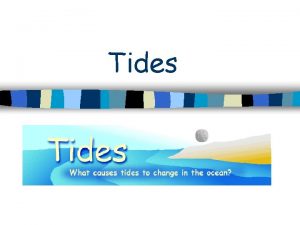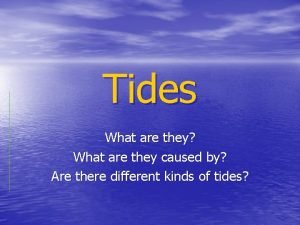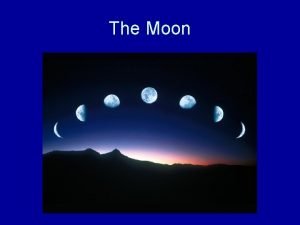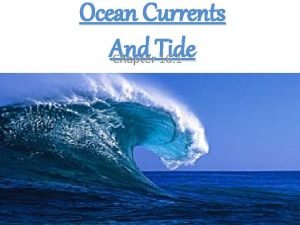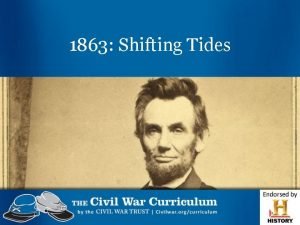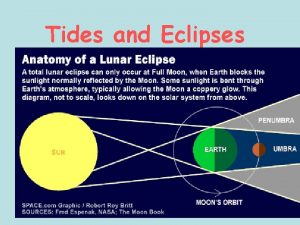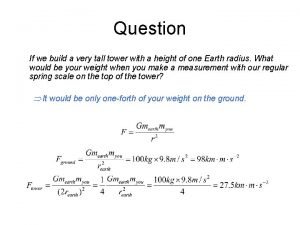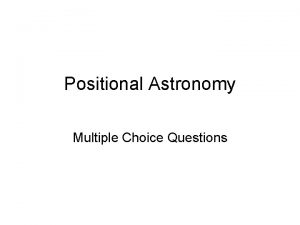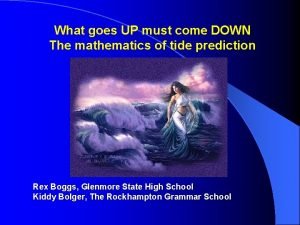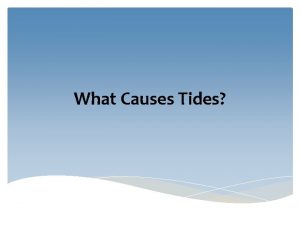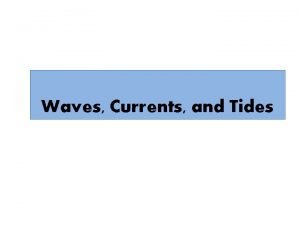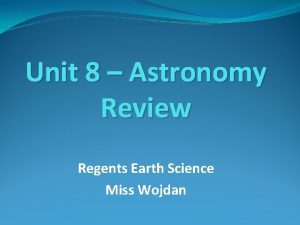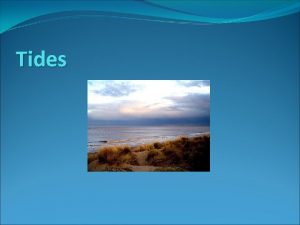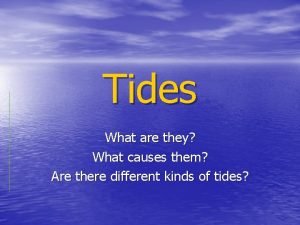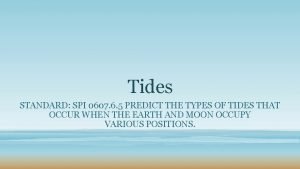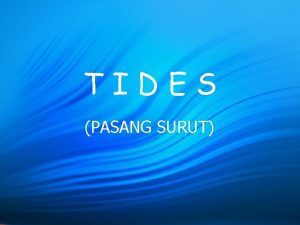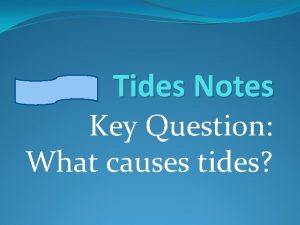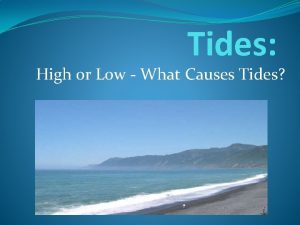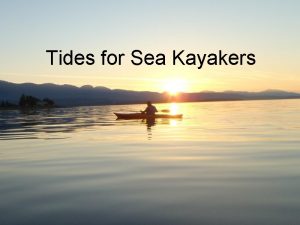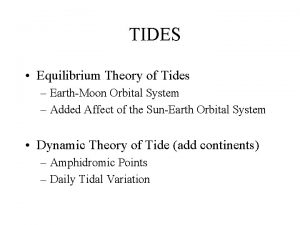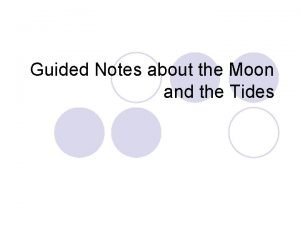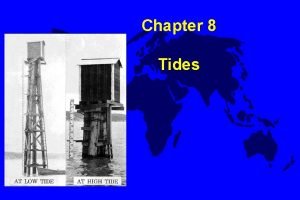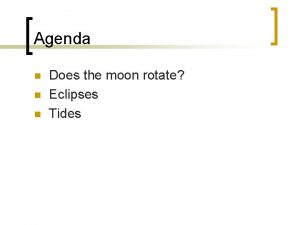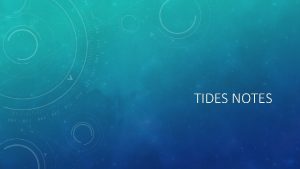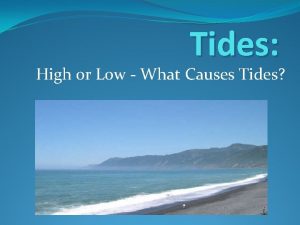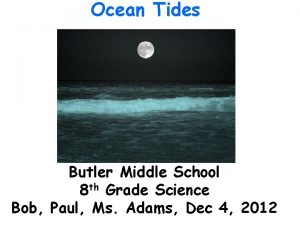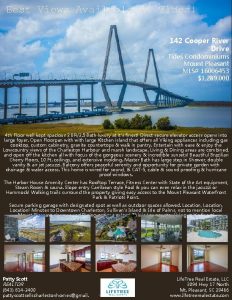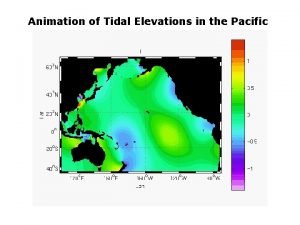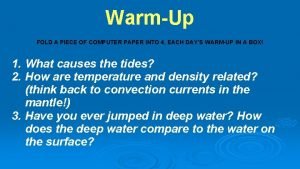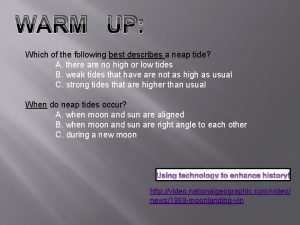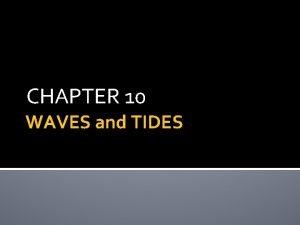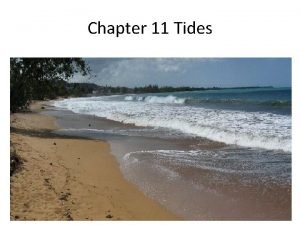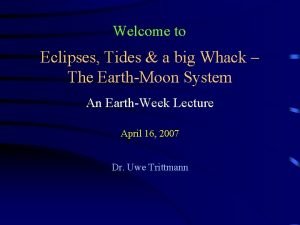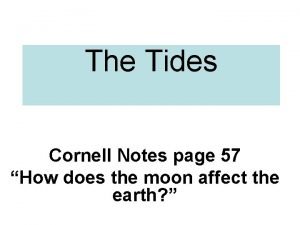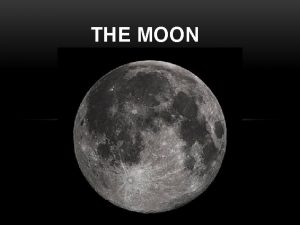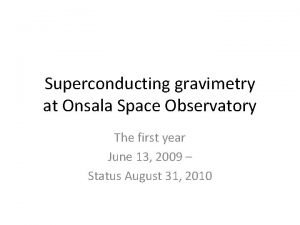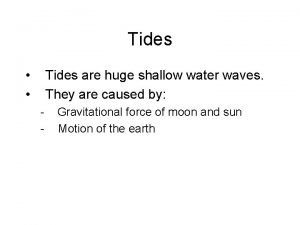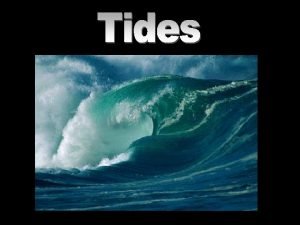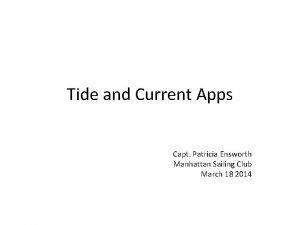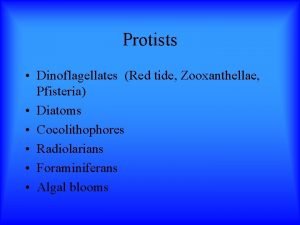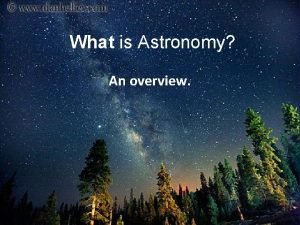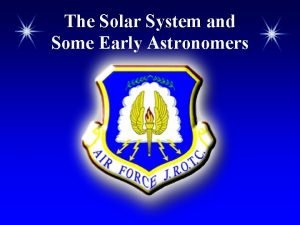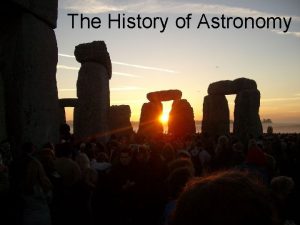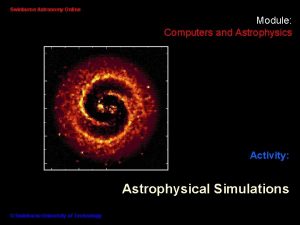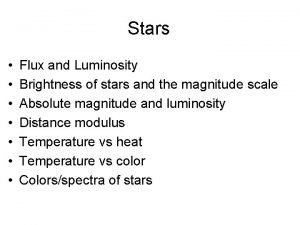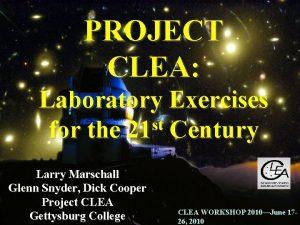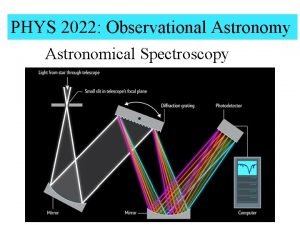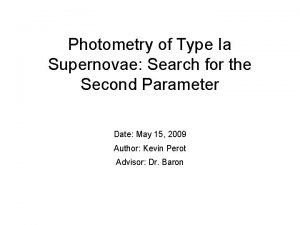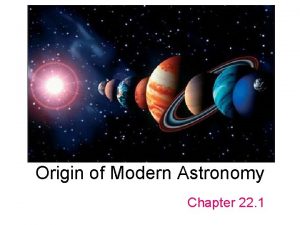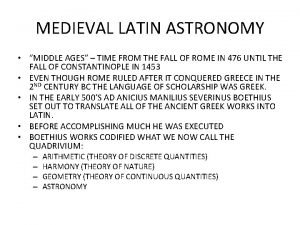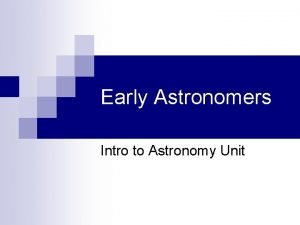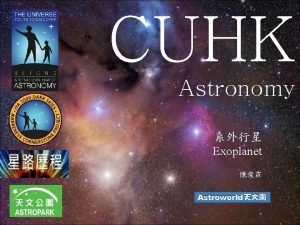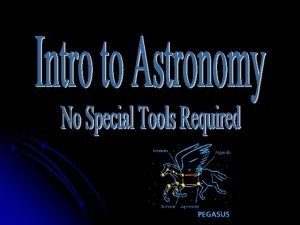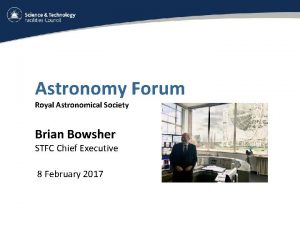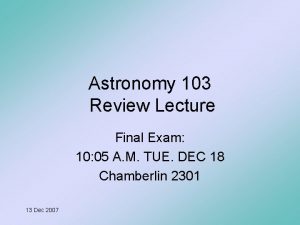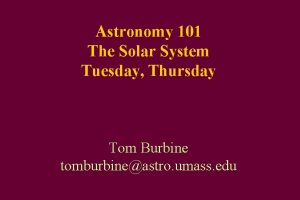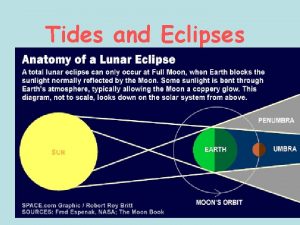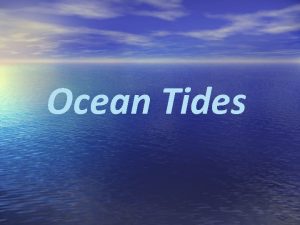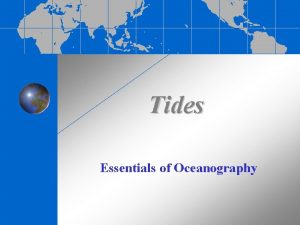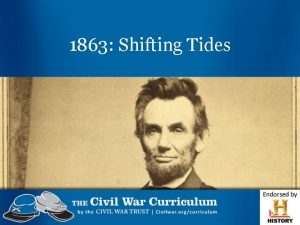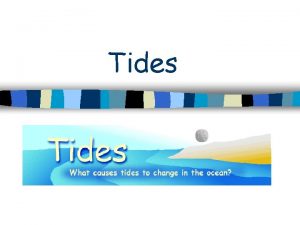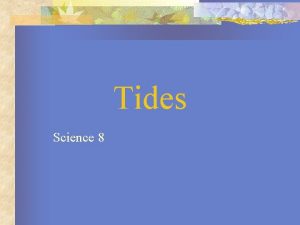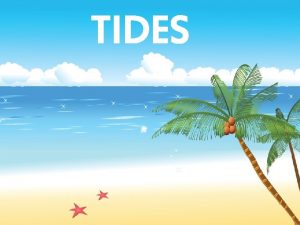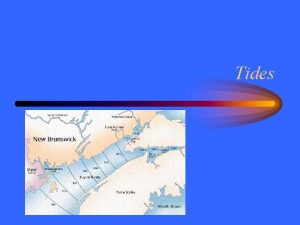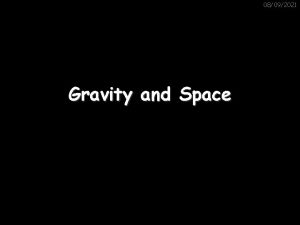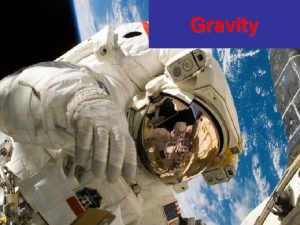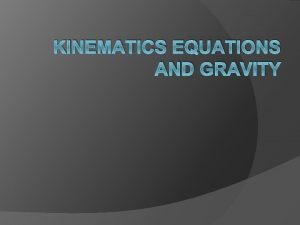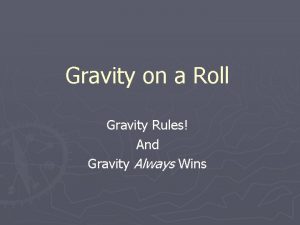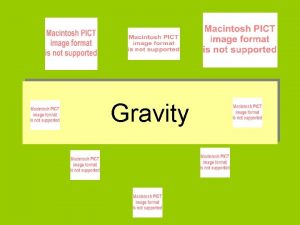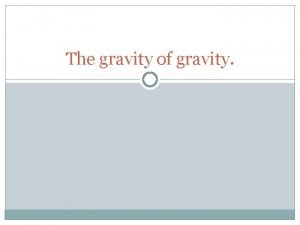The History of Astronomy Gravity Tides and the















































































- Slides: 79

The History of Astronomy, Gravity, Tides, and the Moon

Bell Work 1. What is the habitable zone? 2. What would happen if there was not enough gravity on Earth? 3. How many gas giant planets are there?

Early Astronomy 139 Not only did early humans navigate by means of the sky, but the motions of objects in the sky predicted the changing of the seasons, etc. There were many early attempts both to describe and explain the motions of stars and planets in the sky. All were unsatisfactory, for one reason or another.

140 Geocentric vs. Heliocentric Models of the Solar System Ancient Greeks knew of Sun, Moon, Mercury, Venus, Mars, Jupiter and Saturn. Aristotle vs. Aristarchus (3 rd century B. C. ) Aristotle: Sun, Moon, Planets and Stars rotate around fixed Earth. Aristarchus: 1 st Heliocentric model (Sun is center) Aristotle: But there's no wind - Doesn’t “feel” like we are moving. (Actually orbiting sun at 70, 000 mph!) Difficulties with "Geocentric" model - Retrograde motion of planets - Phases of Venus

Aristarchus 141 1. Written in the 2 nd century BC 2. He calculated the ratio of the distance between the Earth and Sun. • His fault was in his lack of accurate instruments not in his method of reasoning. 3. Aristarchus also found an improved value for the length of the solar year.

The Earth-Centered Universe 142 a A geocentric (Earth-centered) solar system is often credited to Ptolemy, an Alexandrian Greek, although the idea is very old. Image from: http: //abyss. uoregon. edu/~js/ast 123/lectures/lec 02. html

Ptolemy’s Solar System 142 b Ptolemy’s solar system could be made to fit the observational data pretty well, but only by becoming very complicated. Image from: http: //abyss. uoregon. edu/~js/ast 123/lectures/lec 02. html

Geocentric Model of Solar System 143 (Earth Centered) What are some reasons that the geocentric model of the universe seems to make intuitive sense? • It doesn't feel like we are moving – wouldn't there be a wind or something? • Why would things fall down and not towards the center of the universe?

Ptolemy's geocentric model (A. D. 140)

Heliocentric Model 144 a 1. “Rediscovered” by Copernicus in 16 th century. 2. Simply explains retrograde motion. 1. Put Sun at center of everything, but still insisted on circles. 1. Opposed by Catholic Church 2. Copernican revolution – only accepted after his death. Copernicus 1473 -1543

Objections to Copernicus 144 b How could Earth be moving at enormous speeds when we don’t feel it? (Copernicus didn’t know about inertia. ) Why can’t we detect Earth’s motion against the background stars (stellar parallax)? Copernicus’ model did not fit the observational data very well.

145 Galileo & Copernicus Galileo became convinced that Copernicus was correct by observations of the Sun, Venus, and the moons of Jupiter using the newly-invented telescope. Perhaps Galileo was motivated to understand inertia by his desire to understand defend Copernicus’ ideas.

Bell work 1. Which three historical astronomers believed the Heliocentric model of the universe? 2. Which two historical astronomers believed the Geocentric model of the universe? 3. What are the names of Pluto’s 5 moons?

Galileo (1564 -1642), Experimentalist 146 1. Built his own telescope. 2. Discovered four moons orbiting Jupiter. 3. Discovered sunspots. 1. Observed phases of Venus. 5. Was imprisoned for the last 9 years of his life for his scientific discoveries.

Heliocentric model easily accounts for phases of Venus

Geocentric model fails to account for phases of Venus

147 Kepler’s First Law Kepler determined that the orbits of the planets were not perfect circles, but ellipses, with the Sun at one focus. Kepler’s Second Law Kepler determined that a planet moves faster when near the Sun, and slower when far from the Sun. Planet Faster Sun Slower

The Apple & the Moon 148 Isaac Newton realized that the motion of a falling apple and the motion of the Moon were both actually the same motion, caused by the same force - the gravitational force. Newton’s idea was that gravity was a universal force acting between any two objects.

149 a Weight of the Moon Newton reasoned that the centripetal force on the moon was also supplied by the Earth’s gravitational force. ? Fc = mg ® Newton reasoned that the strength of the gravitational force is not constant

149 b Experimental Evidence The Law of Universal Gravitation allowed extremely accurate predictions of planetary orbits. Cavendish measured gravitational forces between human-scale objects before 1800. His experiments were later simplified and improved by von Jolly.

Black Holes 150 When a very massive star gets old and runs out of fusionable material, gravitational forces may cause it to collapse to a mathematical point - a singularity. All normal matter is crushed out of existence. This is a black hole.

151 a Earth’s Tides There are 2 high tides and 2 low tides per day. The tides follow the Moon.

151 b Why Two Tides? Tides are caused by the stretching of a planet. Stretching is caused by a difference in forces on the two sides of an object. Since gravitational force depends on distance, there is more gravitational force on the side of Earth closest to the Moon and less gravitational force on the side of Earth farther from the Moon.

Why the Moon? 152 The Sun’s gravitational pull on Earth is much larger than the Moon’s gravitational pull on Earth. So why do the tides follow the Moon and not the Sun? ® Since the Sun is much farther from Earth than the Moon, the difference in distance across Earth is much less significant for the Sun than the Moon, therefore the difference in gravitational force on the two sides of Earth is less for the Sun than for the Moon (even though the Sun’s force on Earth is more). ® The Sun does have a small effect on Earth’s tides, but the major effect is due to the Moon.

Phases of the Moon Created by Mrs. Bodine-Donahue

The lunar month or synodic month lasts 29 153 a days, 12 hours, and 44 minutes to go from one new moon to the next. During the lunar month, the Moon goes through all its phases.

153 b We only see the Moon because sunlight reflects back to us from its surface.

154 During the course of a month, the Moon circles once around the Earth. If we could magically look down on our solar system, we would see that the half of the Moon facing the Sun is always lit. But the lit side does not always face the Earth!

155 a As the Moon circles the Earth, the amount of the lit side we see changes. These changes are known as the phases of the Moon and it repeats in a certain way over and over.

155 b Moon Phase Descriptions. . . Although this cycle is a continuous process, there are eight distinct stages, called phases.

156 New Moon - The Moon's dark side is facing the Earth. This means that the Sun, Earth, and Moon are almost in a straight line, with the Moon in between the Sun and the Earth. The Moon that we see looks very dark. Waxing Crescent Moon - As the Moon moves around the Earth, we get to see more and more of the illuminated half, and we say the Moon is waxing. This phase is called the crescent moon.

157 Quarter Moon - A week after the new moon, when the Moon has completed about a quarter of its turn around the Earth, we can see half of the illuminated part. This is the first quarter phase. Waxing Gibbous - The Moon appears to be more than one-half but not fully illuminated by direct sunlight. The fraction of the Moon's disk that is illuminated is increasing. ("Waxing" means increasing, or growing larger. )

158 Full Moon - The Moon's illuminated side is facing the Earth. This means that the Earth, Sun, and Moon are nearly in a straight line, with the Earth in the middle. The Moon that we see is very bright from the sunlight reflecting off it. Waning Gibbous Moon - From now on, until it becomes new again, the illuminated part of the Moon that we can see decreases, and we say it's waning. The first week after full, it is called waning gibbous. ("Waning" means decreasing, or growing smaller. )

159 Last Quarter - One-half of the Moon appears to be illuminated by direct sunlight. Sometimes called Third Quarter. The left half of the Moon appears lighted, and the right side of the Moon appears dark. Waning Crescent - The Moon appears to be partly but less than one-half illuminated by direct sunlight. The crescent will grow smaller and smaller every day, until the Moon looks like the New Moon.

After 29 days, 12 hours, and 44 minutes the 160 illuminated half of the Moon again faces away from us, and we come back to the beginning of the cycle: a new moon.

161 Solar eclipses occur less often than lunar eclipse and are shorter in duration. Solar Eclipse – seen for a few minutes and happens a few times a year Lunar eclipse - seen for a few hours and happens at least 2 times a year (could be more)

Moon Phase Misconception. . . "The most common incorrect reason given for the cause of the Moon's phases is that we are seeing the shadow of the Earth on the Moon! But this cannot be correct: when the Moon passes through the shadow of the Earth, we get a lunar eclipse. Anyone who has seen a lunar eclipse, though, might remember that the Moon actually passes through the Earth's shadow only rarely, so that can't be why the Moon has phases. The real reason for the Moon's phases depends on two things: the Moon is round, and the angle it makes with the Earth and Sun changes over its orbit. " - As Quoted From Bad Astronomy

Bell work 1. Who discovered that all the planets have an elliptical rotation pattern? 2. Why does the moon effect the tides more than the sun/ 3. How long is the synodic month?

Directions: Do Not write the words that appear in white!

Event #1 162 a Oct. 4, 1957. The Soviet Union launches a satellite into space named Sputnik 1. It was a very simple device that took measurements of the upper layer of the atmosphere and sent information by radio signals down to the planet. It orbits every hour-and-a-half before it re-entered the atmosphere and burned up 3 months after launch.

Event #2 162 b November 3, 1957: Sputnik 2 is launched, and everyone is stunned to see that thisspacecraft has a “pilot” on board—a dog named Laika (pronounced lye-ee-kuh). The sad part was that Laika was never going to be recovered—there was no plan for thedog to ever land safely on Earth. It was thought to be able to live 10 days in space, but may not have lasted an hour when some of the lifesupport systems malfunctioned.

Event #3 162 c The Americans finally get in the act, on February 1, 1958. Explorer 1 is the USA’s first launched satellite to orbit Earth. It transmitted valuable new information about the protective magnetic field around Earth. It orbited for 12 years before crashing into the Ocean.

162 d It helped geophysicists realize that Earth is not round but slightly pear-shaped, with a slight, symmetric equatorial bulge. America strikes again with Vanguard 1, launched on March 17, 1958. Here’s some impressive news: next to the Moon, Vanguard 1 is the oldest object to orbit Earth. Yep, it’s still out there! This is the first space technology to use solar panels, but transmissions using them ended in 1964. Event #4 Right: It took large, powerful rockets to send any of these objects into orbit.

Event #5 162 e On October 1, 1958, a famous American agency was formed—NASA stands for National Aeronautics and Space Administration. NASA had several goals—continue to gather data about the Earth’s atmosphere and outer space, test new technologies for launching rockets, and of course—beat the Russians! President Eisenhower gets a lesson on space.

Bell Work 1. What was the name of the first satellite? 2. What was so special about Sputnik 2? 3. What was the name of the USA’s first satellite?

163 a Event #6 Russia sends the first man into outer space…a guy named Yuri Gregarin. On April 12, 1961, Vostok 1 blasts off and Yuri returns nearly 2 hours later after completing one orbit and parachuting from a few miles off the ground.

163 b Event #7 May 5, 1961: America sends its first astronaut, Alan Shepard, into space. The mission is called Mercury Freedom 7. It lasted only 16 minutes and didn’t actually go in complete orbit around Earth. Shepard was still hailed as a hero, and he later became the 5 th person to walk on the moon. American scientists lost the race to send a person into space by less than one month. Shepard on the navy ship that rescued him after his ocean splashdown.

Event #8 164 a Vostok 6 blasted off in Russia on June 16, 1963. On board was the first woman in space, so the Russians beat us again. Her name was Valentia Tereshkova, and she recorded data about the atmosphere for 3 days before returning safely to Earth.

Event #9 164 b March 1965: Russia sent off the Voskhod 2, they actually let one of their cosmonauts leave the space ship! Alexei Leonov left the spaceship (attached to it by a tether cord) and stayed out in space for around 12 minutes. Except that his space suit inflated (due to outer space being a vacuum) and he almost wasn’t able to make it back inside the ship.

Event #10 164 c President Kennedy issued the challenge in 1962 that America NEEDED to go to the moon because it would be so hard to do so. And less than a decade later, we did. America just jumped way ahead of Russia in the space race. On July 20, 1969, the Apollo 11 mission lands on the moon, and Neil Armstrong utters the famous words, “one small step for a man, one giant leap for mankind. ” USA! This is awesome.

Event #11 April 11, 1970 165 If you’ve seen the movie Apollo 13 starring Tom Hanks and Kevin Bacon, you know that it’s a story of Americans overcoming horrible odds. After an oxygen tank explodes on the way to the Moon, the crew of Apollo 13 and NASA scientists in Houston are forced to abandon the plan to land on the Moon and instead just get the men home without killing them. April 17, 1970 it splashed down in the Pacific Ocean. NASA scientists working frantically. The crew safe, at last.

Event #12 166 The next Apollo mission, Apollo 14, lands on January 31, 1971 in the exact spot that Apollo 13 was supposed to explore. Alan Shepard leads this expedition, where millions of viewers watched on television as the astronauts played golf and threw javelins on the moon. Faith in NASA is restored.

Bell Work 1. Who was the first man in space? 2. Which country sent the first woman into space? 3. What was the name of the first mission to land on the moon?

167 Event #13 NASA scientists had envisioned a permanent space station, and in 1973, Skylab began a 12 -year experiment to see how practical the idea was. Skylab used large solar panels to provide electricity for itself, and allowed other spacecraft to float near it and “dock. ” This allowed crew members to enter Skylab and leave when they needed to. Three such dockings occurred. The Skylab experiment ended, but provided valuable information about the realism of life in space. A docking pod, where crew fro another space flight could enter Skylab.

Event #14 168 a July 1975 – The final Apollo mission was a good one. After nearly 20 years of outdoing each other, America and Russia agree to do a mission together. The Space Race is pretty much done at this point—we can be friends now. Apollo 18 and the Soviet ship Soyuz 19 fly into space and dock with each other—allowing the American and Russian crew members to meet in space. Cool.

Event #15 168 b Finally, a space craft you recognize easily. On August 12, 1978, the Enterprise is the first space shuttle to be tested. Carried on the back of a much larger plane, the Enterprise “let go” and glided to a safe landing. Now NASA was confident that the shuttles could do missions on their own and perform a rolling landing.

Event #16 168 c It was just a matter of time (a few years later) when NASA would actually send one of the new space shuttles into space for a real mission. In 1981, the Columbia blasted off with the help of booster rockets, then landed on an Air Force base in California after 2 days in space.

Event #17 168 d Yet another space shuttle, the Challenger, blasts off on April 4, 1983. Part of the 5 -day mission involved a four hour spacewalk where 2 of the crew members performed repairs of the shuttle. Nice work, gentlemen. 80 s haircuts. Cool.

169 a Event #18 June 18, 1983, America finally sends its own female astronaut. Her name is Sally Ride, and she performs numerous missions afterward and becomes a hero to many!

169 b Event #19 August 30, 1984…the space shuttle Discovery successfully carries 3 communications satellites into space, a first for a shuttle mission. NASA keeps trying new techniques to address old problems with great success. 80 s hair is out of control in zero gravity.

169 c Event #20 There were 4 space shuttles in service—Discovery, Challenger, Columbia, Enterprise, and Atlantis. On October 3, 1985, Atlantis joins the squad as the fifth (and final) shuttle to be launched into space. Atlantis carries some secret defense satellites into space (maybe to spy on our old friends, the Soviet Union? )

Event #21 170 On January 28, 1986, the shuttle Challenger lifted off, as planned. Kids all over America were gathered around televisions to watch the event live as it happened, and teachers were ready to do a space lesson right afterward. It all changed as 73 seconds later, the shuttle blew up in mid-air, killing the crew and shocking the world. Stunned silence just a minute later Clapping and cheering here…

171 a Event #22 NASA now had 1 of two MAJOR incidents that shook America’s confidence in the space program. The explosions of Challenger slowed down how often we went into space. Fortunately, one of the big achievements that happened after the Columbia disaster was the successful launching of the Hubble Space Telescope by the shuttle Discovery in 1990. This telescope has given us incredible images of events and objects far distant in the universe. Good job, Discovery. One of the thousands of awesome images taken by the H. S. T.

171 b Event #23 In 1992, a new space shuttle, Endeavour, was launched into space. It was built as a better replacement to Challenger, which exploded 6 years prior. After its July 5 launch, three crewmen space walked to grab a satellite that wasn’t responding to commands properly. After the longest space walk ever, the satellite was repaired and sent back into orbit. Endeavour was retired in 2010 after performing one last space mission.

171 c Event #24 Oh no, not again. On February 1, 2003, people in the Dallas/Ft. Worth area felt a thud slam through their neighborhoods. The shuttle Columbia, returning from a long, successful space flight, was cruising through the atmosphere preparing to land in Florida. Days before, during the launch of the shuttle, a piece of foam damaged the heat shield on one wing of the shuttle. It didn’t become a problem until the shuttle entered our atmosphere going around twenty times the speed of sound. The heat from friction with the air burst through the weak wing, and debris from the shuttle flying apart was found in several states! All 7 crew members died.

Event #25 172 Created mainly by five nations—a space station appropriately named the International Space Station. Construction began 20 November 1998 and took 10 years and over 30 missions to assemble. It has been continuously manned for a record of over 4, 700 days since 2 November 2000. The station experiences a sunrise and sunset every 90 minutes as it orbits the Earth. They plan to keep the station running until 2028, those involved with the space station are anxious to keep it going longer. The I. S. S. is big enough to see without a telescope if you catch it at the right time of year at night.

173 a 1998 3 July 1998 - Japan launcher Mars Orbiter – Nozomi 11 Dec. 1998 – USA Attempts Mars Orbiter – Mars Climate Orbiter

173 b 1999 3 Jan. 1999 – USA Attempted both the Mars Polar Lander And Deep Space 2 – Two Surface probes that never made contact after launching and are presumed lost.

173 c 2001 7 April 2001 – USA launched the 2001 Mars Odyssey and it began taking mineralogical and radiation samples and data 13 March 2002 and stopped in July 2004. It will also be used as a communications relay.

2003 10 June 2003 – USA – The Spirit a Mars Rover Arrived at Mars January 2004. It was projected to last 90 days, but continues to operate. A Second Rover was also launched that year called – The Opportunity - It is also still in operation. 174 a

2004 3 Aug, 2004 – USA – Messenger a Mercury Orbiter 12 Dec 2005 it fired its thruster to put in a course for a Venus flyby that took place 5 June 2007 It had 3 Mercury flybys: 14 Jan 2008, 6 Oct 2008, and 29 Sept 2009 174 b

175 2006 19 Jan 2006 The New horizons was launched – was set to reach Pluto, Charon, and the Kuiper Belt 28 Feb 2007 – Passed Jupiter 8 June 2008 – crossed Saturn's orbit Pluto flyby is 14 July 2015 – it took pictures of Pluto and its moons: Charon, Nix, Hydra, Styx, and Kerberos The Kuiper Belt part of the mission will last 5 to 10 years

2008 22 Oct 2008 – India Launched the Chandrayaan 1 - lunar orbiter 31 Aug 2009 – The Indian Space Research Organization Officially terminated the Chandrayaan 1 Mission after contact was lost on 28 Aug 2009 176 a

2009 176 b 7 March 2009 – USA The Kepler – an Extrasolar Terrestrial Planet Detection Mission to look for other planets that could have habitable conditions The Kepler Space Telescope has verified over 1, 000 planets. All are smaller than Earth and have slightly cooler temperatures.

177 2010 20 May 2010 – Japan – Launched Akatsuki (translates to “Dawn”) – a Venus orbiter – It flew by Venus 07 Dec 2010 – They will try a Venus orbit again 7 December 2015 1 Oct 2010 – China – launched the Chang’e 2 lunar mission. The Lunar mission was from 06 Oct 2010 until 08 June 2011. After which, it took close up images of asteroid 4179 on 13 December 2012.

2011 05 Aug 2011 USA launched the Juno to orbit Jupter. It should arrive at Jupiter in 2016. 08 Nov 2001 – Russia launched the Phobos-Grant to study the moon with China's Yinghuo-1 attached to it. But it failed and re-entered the Earth’s atmosphere on 15 Jan 2012. 26 Nov 2011 – USA launched the Mars Science Laboratory. It reached Mars August 2012 and touched down on 6 August. It took rock and soil samples to look for signs of life. 178

179 2013 06 Sept 2013 – USA Launched Ladee a lunar orbiter from Wallops Island in VA. Orbited the moon from 21 Nov 2013 to 01 March 2014. It then landed on the moon on 18 April 2014. We now know the moon’s thin atmosphere is made of helium, neon, and argon. 05 Nov 2013 – India launched the Mangalyaan – mars orbiter 18 Nov 2013 – USA launched the Maven Mars Scout Orbiter 01 Dec 2013 – China launched the Chang’e 3 lunar lander and rover

2014 23 Oct 2014 – China launched the Chang’e 5 test vehicle a lunar flyby and return mission 03 Dec 2014 – Japan launched the Hayabusa 2 and Procyon to study asteroids 180

181 Future plans There are no new space plans announced for 2015. In 2016 the USA is planning 2 launches. One in March 2016 called the In. Sight a Mars lander to study its crust, mantel, and core with it arriving in September 2016. The Osiris-Rex will launch in late 2016 to study the Bennu asteroid with an arrival of 2018 and return to Earth in 2013. July 2016 the European Space Agency launches a mission that will take 7. 5 years to get to Mercury. It should arrive January 2024 and be in operation for 1 to 2 years.
 Compare and contrast spring tides and neap tides.
Compare and contrast spring tides and neap tides. The difference between spring tides and neap tides
The difference between spring tides and neap tides Learning astronomy by doing astronomy activity 1 answers
Learning astronomy by doing astronomy activity 1 answers Learning astronomy by doing astronomy
Learning astronomy by doing astronomy Learning astronomy by doing astronomy activity 1 answers
Learning astronomy by doing astronomy activity 1 answers Gravity for dummies and dummies for gravity equations
Gravity for dummies and dummies for gravity equations What are tides and how are they caused
What are tides and how are they caused During which phase of the moon do neap tides occur
During which phase of the moon do neap tides occur Citlalli dominguez
Citlalli dominguez Types of tides
Types of tides Shifting tides timeline and map
Shifting tides timeline and map Shifting tides timeline and map
Shifting tides timeline and map Shifting tides timeline and map
Shifting tides timeline and map Tides and eclipses
Tides and eclipses He can turn the tide and calm the angry sea
He can turn the tide and calm the angry sea He can turn the tides
He can turn the tides Waves and tides
Waves and tides Spring and neap tides
Spring and neap tides Lesson outline lesson 3 eclipses and tides answer key
Lesson outline lesson 3 eclipses and tides answer key Eclipses and tides lesson 3
Eclipses and tides lesson 3 Cleaning the tides of san diego and tijuana
Cleaning the tides of san diego and tijuana Astronomy questions and answers multiple choice
Astronomy questions and answers multiple choice Michigan state astronomy
Michigan state astronomy Mooloolaba tides
Mooloolaba tides Why are there tides
Why are there tides Study jams waves and currents
Study jams waves and currents Ocean tides observed at coastal locations
Ocean tides observed at coastal locations Why are there tides
Why are there tides What are tides
What are tides Spi tides
Spi tides Tides adalah
Tides adalah Tides notes
Tides notes Spring tides occur when
Spring tides occur when Diurnal tide definition
Diurnal tide definition How does the sun affect tides
How does the sun affect tides Equilibrium theory of tides
Equilibrium theory of tides Tide
Tide Formation of tides
Formation of tides Characteristics of tides
Characteristics of tides What are tides?
What are tides? Tides notes
Tides notes When does a spring tide occur
When does a spring tide occur On stranger tides box office
On stranger tides box office Butler beach tides
Butler beach tides 142 cooper river drive
142 cooper river drive Tidal energy animation
Tidal energy animation Types of tides
Types of tides Which phrase describes neap tides?
Which phrase describes neap tides? Gore bay tides
Gore bay tides Wave train
Wave train Home.hiwaay.net/ krcool/astro/moon/moon tides/
Home.hiwaay.net/ krcool/astro/moon/moon tides/ Diurnal tide cycles occur ______.
Diurnal tide cycles occur ______. Why do tides occur
Why do tides occur Spring tides
Spring tides How many days for a moon cycle
How many days for a moon cycle Ocean tides
Ocean tides Tides
Tides Tides
Tides Alma tides
Alma tides Aye tides
Aye tides Pfisteria
Pfisteria What is astronomy
What is astronomy Claudius ptolemy astronomy contributions
Claudius ptolemy astronomy contributions Aristotle astronomy
Aristotle astronomy Swinburne astronomy online
Swinburne astronomy online Astronomy
Astronomy Flux and luminosity
Flux and luminosity Project clea
Project clea Phys2022
Phys2022 Distance ladder astronomy
Distance ladder astronomy Chapter 22 origin of modern astronomy answer key
Chapter 22 origin of modern astronomy answer key Astronomy in medieval times
Astronomy in medieval times Astronomy definition earth science
Astronomy definition earth science Claudius ptolemy astronomy contributions
Claudius ptolemy astronomy contributions Cuhk astronomy
Cuhk astronomy Astronomy vs astrology
Astronomy vs astrology Astronomy forum uk
Astronomy forum uk Astronomy 103 final exam
Astronomy 103 final exam Astronomy 101 formulas
Astronomy 101 formulas Astronomy science fair projects
Astronomy science fair projects

